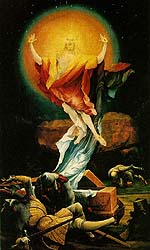
|
Old Testament
New Testament
Gospels
Acts
Paul's Letters
General Letters
Revelation
Topical Studies
Beginning the Journey (for new Christians). en Español

|
Old Testament
New Testament
Gospels
Acts
Paul's Letters
General Letters
Revelation
Topical Studies

|
Home
Bible Studies
Articles
Books
Podcasts
Search
Menu
Donate
About Us
Contact Us
FAQ
Sitemap
Appendix 11. A Possible Harmonization of the Resurrection Accounts
by Dr. Ralph F. WilsonAudio (7:40)
 Matthias Grünwald, 'Resurrection' (1512-1516), 106x112-1/2 in. The Isenheim Alterpiece (Diptych), Musee d' Unterlinden, Colmar. |
The gospel accounts of the resurrection are similar, but each is different.
First of all, it's pretty clear that Mark 16:9-19, the so-called longer ending of Mark, wasn't part of the original gospel, that ended -- at least the surviving edition that we have -- with verse 8. Perhaps the last page was lost. Verses 9-19 were added by the early church because it seemed strange that Mark ended abruptly as it did. Not that these verses are misleading, but they aren't part of the original gospel.
When you compare each of the stories, you can find a number of differences. For example:
- Women. In the Synoptic Gospels, Mary Magdalene and other women go to the tomb. In John's account, Mary Magdalene goes alone.
- Appearance to the women. In Matthew 28:9, Jesus appears to the women before they tell the disciples. In John 20:13-17, Jesus appears to Mary Magdalene (also in the longer ending of Mark) -- after she reports to the disciples. In Mark, the women tell no one of what they had seen.
- Number of angels. In Matthew and Mark one angel appears; in Luke and John there are two angels.
- Purpose of the women's visit. In Matthew, they go to look at the tomb. In Mark and Luke, they bring spices to anoint Jesus' body. In John the anointing took place on Friday night and no purpose for Mary's visit is given.
- Grave clothes. In Matthew and Mark, Jesus is wrapped in a large linen shroud (sidrōn). In John 19:40; 20:5-7 and Luke 24:12, Jesus is wrapped in strips of linen (othonion). See the discussion below.
- Location. In Matthew and Mark, Jesus' resurrection appearances are in Galilee, while Luke only records appearances in the vicinity of Jerusalem.
My point isn't to try to pick apart the account or cause you to disbelieve it. But to stimulate you to see what's there. Most of these differences are minor and can be explained or harmonized rather easily.
Eyewitness Accounts
A more troubling question is if eyewitnesses can't seem to get their stories straight, whether we can believe the story or not. When you think about it, you realize that these very differences validate the authenticity of the story.
Whenever you have eyewitnesses testify to any event that they all see, there'll be minor points of difference in what they saw and how they perceived the event. If all the eyewitnesses agree in every detail, a good investigator begins to suspect collusion between the witnesses before testifying.
The Church has been aware of these minor differences in the resurrection accounts for many centuries. Some might express concern with how this might affect our doctrine of the authority of scripture (2 Timothy 3:16). But surely our understanding of the inspiration of scripture must be large enough to encompass the gospel accounts as we find them. Rather than seeing these accounts as evidence of error, the Church has viewed them as evidence of authenticity, representing various eyewitness traditions that are remarkably united on the main points.
Points of Agreement
In the big, important things we see five main points of agreement. They include:
- Jesus was dead and buried.
- The disciples were not prepared for Jesus' death. They were overcome with confusion.
- The tomb was found on Easter morning to be empty. But this in itself didn't inspire faith. Mary thought the body was stolen.
- The disciples encountered a number of experiences that they took to be appearances of Jesus risen from the dead.
- The disciples proclaimed the resurrection of Jesus in Jerusalem, near where he had been buried.[1007]
 Entire study is available in paperback, Kindle, and PDF formats. |
My Biblical exegesis professor at Fuller Theological Seminary, George Eldon Ladd, didn't really recommend a harmonization approach to the resurrection accounts. However, to answer his own question of whether the accounts could be harmonized, he worked out the following harmonization, he said, for his own amusement.[1008] P Later he found a nearly identical harmonization by Michael C. Perry. Here is George Ladd's approach to a harmonization:
- The earthquake and removal of the stone occurs before dawn.
- A group of four women come early to the tomb, wondering who will move the stone. As they approach, they are amazed to see that the stone has been rolled away.
- Mary rushes off to tell Peter and John that the body of Jesus has been stolen (John 20:2).
- The other women stay in the garden. They enter the tomb and are met by two angels, who tell them to carry the word of the resurrection to the disciples.[1009]
- The women rush away from the garden, filled with mingled emotions of fear and joy, speaking to no one about the vision of the angels at the empty tomb (Mark 16:8).
- Later in the day, Jesus meets them. (Matthew 28:9 does not say that this meeting occurred in the garden.) They had to run away from the tomb. Jesus tells them to bear the word to the disciples; they depart to find the disciples, who are not together but scattered (Matthew 26:56).
- Peter and John, having been informed by Mary, come to the tomb after the women have left. They see the clothes; vague comprehension dawns on John. They rush off to gather the disciples.
- Mary returns to the tomb after Peter and John have left; they had run to the tomb (John 20:4), leaving Mary behind. She still thinks the body has been stolen. She is weeping outside the tomb, knowing nothing of the experience of the women she had left in the garden. She sees the two angels, then Jesus (John 20:11-17).[1010] P
- After the first shock of amazement had worn off, the women find some of the disciples; the disciples cannot believe the fanciful story (Luke 24:11).
- The disciples have gathered together.
- Mary arrives and tells her experience (John 20:18).
- That afternoon, two disciples encounter Jesus on a walk to Emmaus.
- Sometime that afternoon, there is an appearance to Peter (Luke 24:34).
- That evening, the disciples are all together in the closed room. They had been scattered, but the testimony of the women, of Peter and John, then of Mary, serves to bring them all together. Thomas was absent.
- A second appearance to the eleven, including Thomas.
- Galilee (Matthew 28:16). The appearance by Tiberias (John 21) and to the 500 brethren (1 Corinthians 15:6).
- Return to Jerusalem; the final appearance and ascension.
Ladd concludes,
"This harmonization does not mean that the author intends to suggest that the events actually happened in this order. We cannot know."[1011]
[1007] Eldon G. Ladd, I Believe in the Resurrection (Eerdmans, 1975), pp. 93.
[1008] Ladd, Resurrection, pp. 91-93.
[1009] Ladd says, "The problem of a young man of Mark 16:5, two men of Luke 24:4, angels of Luke 24:23, is one of the ordinary Synoptic divergencies -- of detail" (Resurrection, p. 92).
[1010] Ladd notes that Mark's longer ending, 16:9 here, is not original (Resurrection, p. 92).
[1011] Ladd, Resurrection, p. 93.
Copyright © 2025, Ralph F. Wilson. <pastor![]() joyfulheart.com> All rights reserved. A single copy of this article is free. Do not put this on a website. See legal, copyright, and reprint information.
joyfulheart.com> All rights reserved. A single copy of this article is free. Do not put this on a website. See legal, copyright, and reprint information.

